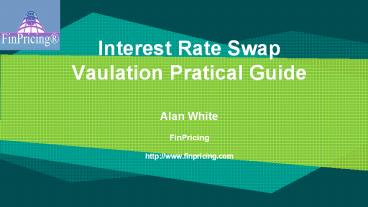Interest Rate Swap Valuation Practical Guide PowerPoint PPT Presentation
Title: Interest Rate Swap Valuation Practical Guide
1
Interest Rate Swap Vaulation Pratical
GuideAlan WhiteFinPricinghttp//www.finprici
ng.com
2
Swap
- Summary
- Interest Rate Swap Introduction
- The Use of Interest Rate Swap
- Swap or Swaplet Payoff
- Valuation
- Practical Notes
- A real world example
3
Swap
- Interest Rate Swap Introduction
- An interest rate swap is an agreement between two
parties to exchange future interest rate payments
over a set period of time. - An interest rate swap consists of a series of
payment periods, called swaplets. - Vanilla Interest Rate Swaps involve the exchange
of a fixed interest rate for a floating rate, or
vice versa. - There are two legs associated with each party a
fixed leg and a floating leg. - Swaps are OTC derivatives that bear counterparty
credit risk.
4
Swap
- The Use of Interest Rate Swap
- Swaps are the most popular OTC derivatives that
are generally used to manage exposure to
fluctuations in interest rates. - Swaps can also be used to obtain a marginally
lower interest rate. Thus they are often utilized
by a firm that can borrow money easily at one
type of interest rate but prefers a different
type. - Swaps allow investors to adjust interest rate
exposure and offset interest rate risk. - Speculators use swaps to speculate on the
movement of interest rates. - More and more swaps are cleared through central
counterparties (CCPs) nowadays.
5
Swap
- Swap or Swaplet Payoff
- From the fixed rate payer perspective, the payoff
of a swap or swaplet at payment date T is given
by - ?????????? ?????????? ????(??-??)
- where
- N- the notional
- ?? accrual period in years (e.g., a 3 month
period 3/12 0.25 years) - R the fixed rate in simply compounding.
- F the realized floating rate in simply
compounding - From the fixed rate receiver perspective, the
payoff of a swap or swaplet at payment date T is
given by - ?????????? ???????????????? ????(??-??)
6
Swap
- Valuation
- The present value of a fixed rate leg is given by
- ???? ?????????? ?? ???? ??1 ?? ?? ?? ?? ??
- where t is the valuation date and ?? ?? ??(??,
?? ?? ) is the discount factor. - The present value of a floating leg is given by
- ???? ?????????? ?? ?? ??1 ?? ?? ?? ?? ??
?? ?? ?? - where ?? ?? ?? ??-1 ?? ?? -1 / ?? ?? is
the forward rate and s is the floating spread. - The present value of an interest rate swap can
expressed as - From the fixed rate receiver perspective, ????
???? ?????????? - ???? ?????????? - From the fixed rate payer perspective, ???? ????
?????????? - ???? ??????????
7
Swap
- Practical Notes
- First of all, you need to generate accurate cash
flows for each leg. The cash flow generation is
based on the start time, end time and payment
frequency of the leg, plus calendar (holidays),
business convention (e.g., modified following,
following, etc.) and whether sticky month end. - We assume that accrual periods are the same as
reset periods and payment dates are the same as
accrual end dates in the above formulas for
brevity. But in fact, they are different due to
different market conventions. For example, index
periods can overlap each other but swap cash
flows are not allowed to overlap. - The accrual period is calculated according to the
start date and end date of a cash flow plus day
count convention
8
Swap
- Practical Notes (Cont)
- The forward rate should be computed based on the
reset period (index reset date, index start date,
index end date) that are determined by index
definition, such as index tenor and convention.
it is simply compounded. - Sometimes there is a floating spread added on the
top of the floating rate in the floating leg. - The formula above doesnt contain the last live
reset cash flow whose reset date is less than
valuation date but payment date is greater than
valuation date. The reset value is - ???? ?????????? ?? 0 ?? ?? 0 ?? 0
- where ?? 0 is the reset rate.
9
Swap
- Practical Notes (Cont)
- The present value of the reset cash flow should
be added into the present value of the floating
leg. - Some dealers take bid-offer spreads into account.
In this case, one should use the bid curve
constructed from bid quotes for forwarding and
the offer curve built from offer quotes for
discounting.
10
Swap
- A Real World Example
Leg 1 Specification Leg 1 Specification Leg 2 Specification Leg 2 Specification
Currency USD Currency USD
Day Count dcAct360 Day Count dcAct360
Leg Type Fixed Leg Type Float
Notional 5000000 Notional 5000000
Pay Receive Receive Pay Receive Pay
Payment Frequency 1M Payment Frequency 1M
Start Date 7/1/2015 Start Date 7/1/2015
End Date 3/1/2023 End Date 3/1/2023
Fixed Rate 0.0455 Spread 0
Index Specification Index Specification
Index Type LIBOR
Index Tenor 1M
Index Day Count dcAct360
11
Thanks!
You can find more details at http//www.finpricing
.com/lib/IrSwap.html

